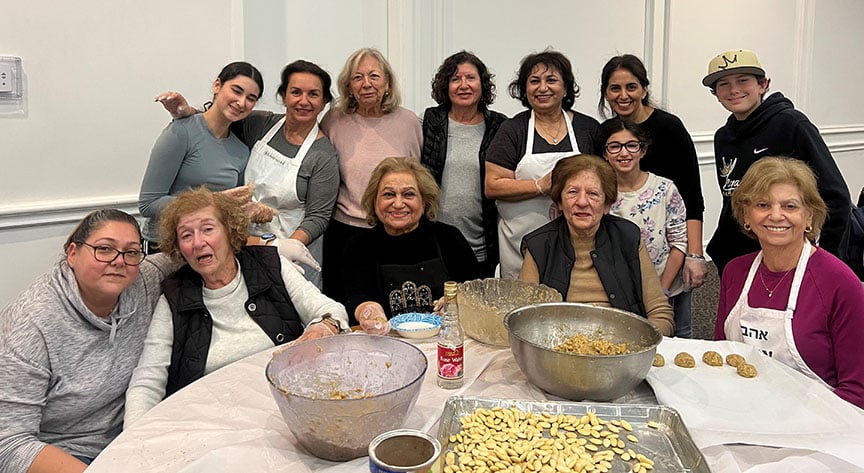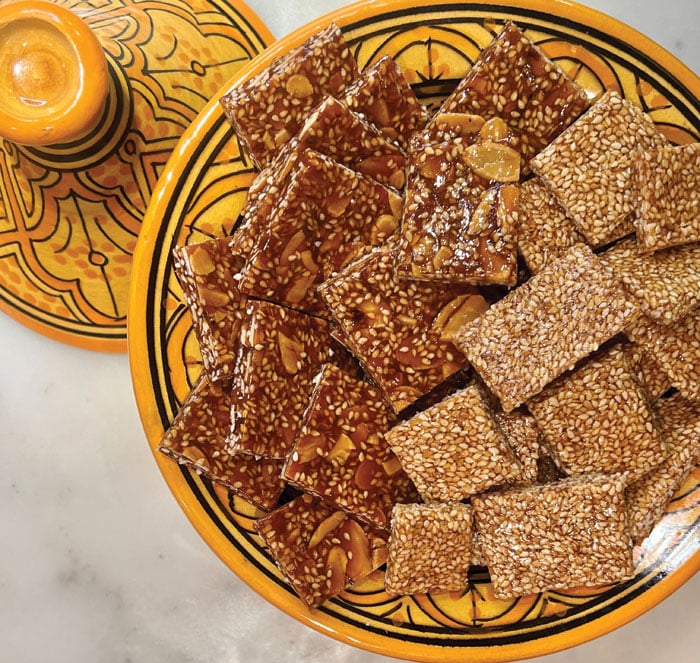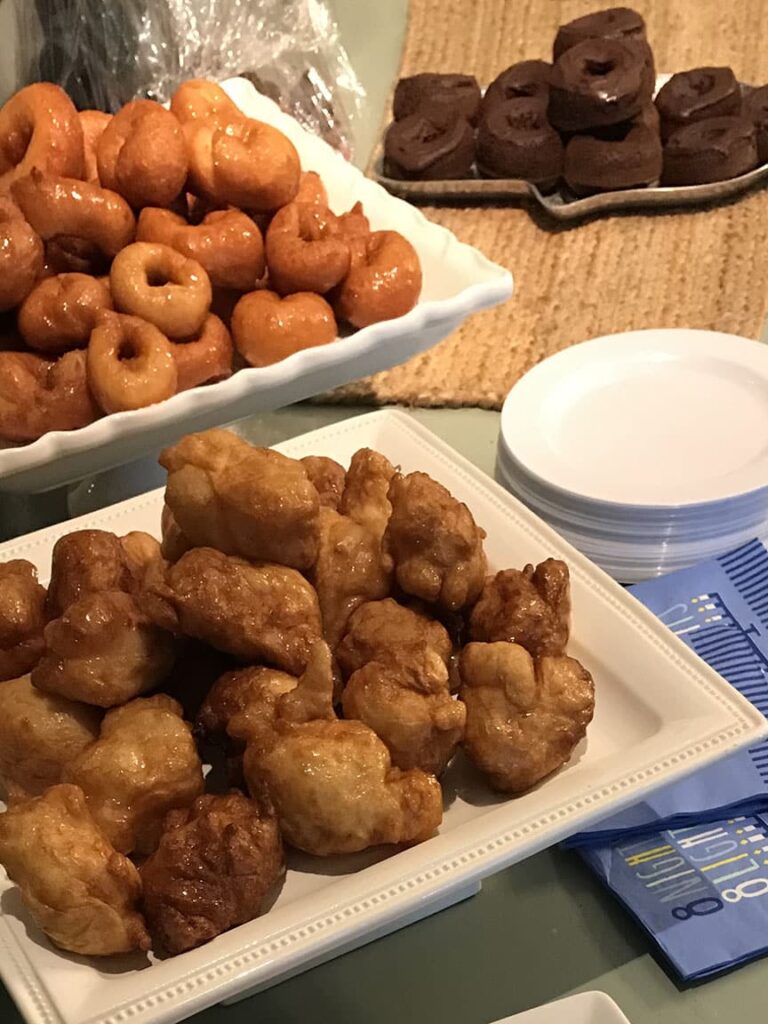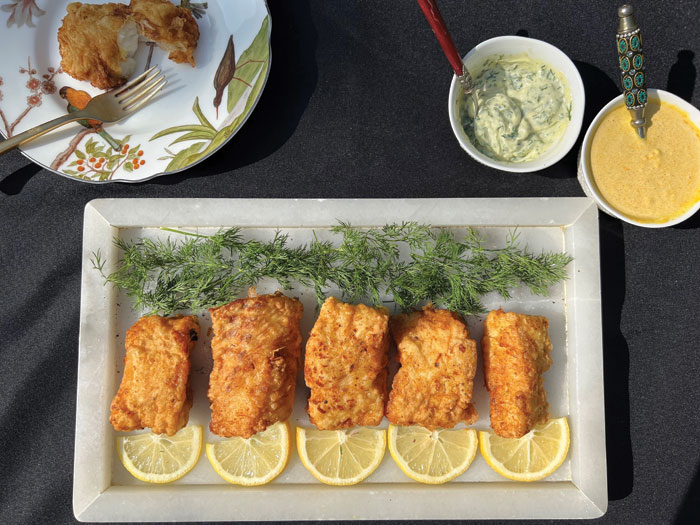Baking Our Way to Purim Sameach
What could be better than the enticing aromas of freshly baked Purim treats.

For Rachel and I, the annual Kahal Joseph Purim Community Bake is one of our favorite events! I mean, what could be better than the enticing aromas of freshly baked Purim treats.
For us, Kahal will always feel like home. In our early twenties, we spent many, many Monday nights at the Sephardic Educational Center’s Classes for the Masses and many Shabbats and holidays praying there. Our boys grew up spending Shabbats playing there and celebrated their bar mitzvahs there. We have had many amazing cooking classes there and now we have a wonderful monthly yoga and meditation class with artist Leat Silvera (follow @leatsilveraart). But the Bake is unique and special.

We love seeing the grandmothers, mothers, daughters, granddaughters and great-granddaughters (and even a grandson or two) working together to bake. It’s incredible to watch the recipes and techniques passing down from generation to generation.
(For me, it is especially touching to hear the ladies speaking Iraqit, the unique Judeo-Arabic spoken during the 2,600 year Babylonian exile, because it brings back beautiful memories of both my grandmothers.)
It is also a wonderful opportunity to hear the stories of the lovely women who bake there. While the majority of the Jews left Iraq for Israel in the early 1950’s in Operation Ezra and Nehemiah, there were a brave minority who stayed. Rosy Atraghji, who has generously helped Rachel and I with our baking demos, is one of those. In Baghdad, Rosy was good friends with Albert Nissan. She was earning her degree from the College of Architecture and he worked for an auto parts company. But the idyll was disrupted in 1970, when he and his younger brother and sister were arrested and imprisoned by the Iraqi authorities. They alleged that their father (who had passed away many years before) was not an Iraqi citizen and that his children were not citizens and must be deported. In desperation, their mother spent many days going from consulate to consulate trying to find a country that would give them asylum. Luckily, she walked into the Dutch consulate and her children were issued visas to the Netherlands.
Soon after, Rosy escaped Iraq to Iran. In Teheran, she was stateless, but again the Dutch embassy issued her a visa. She was able to join Albert in Amsterdam, where they were soon married. Albert studied aeronautical engineering at the University of Delft and after he graduated, he worked in The Hague.
In 1988, they came to Los Angeles with their children, Marc and Jaimie, where they were reunited with Rosy’s mother and sisters Rachel and Yvette.
Rosy and her sister Yvette Dabby tell us that in Iraq, especially before Purim, whole days were dedicated to baking huge batches of baked delicacies. As a little girl, Yvette remembers being fascinated by the lady her family hired to make the three feet wide, ultrathin layers of phyllo pastry. The pastry would then be transformed into syrupy baklava and crispy malfouf (crushed walnuts, cinnamon and cardamom filled cigars). They would make pillowy cheese sambusak and crispy nut-filled sambusak and baba tamar, crispy date-filled cookies.
All the pastries would be placed on large trays and sent to be baked in huge commercial ovens. On Purim, an assortment would be placed on beautiful platters and given as Mishloach Manot to friends and family.
This week, the women also baked huge quantities of baba tamar and cheese sambusak. (I got to sample straight out of the oven because I was in the dairy kitchen with my bestest friends David and Louise Elias.)
It was beautiful to watch four generations of Tikva Iny’s family making her famous cinnamon spiced, rose water infused almond macaroons. (Tikva’s father Naim Naba and my grandfather Aba Naji were school friends in Baghdad. They both attended university and became teachers and they corresponded and visited each other in Israel and Los Angeles.)
I’m sure the recipients of these Mishloach Manot will be thrilled.
Purim Sameach!
—Sharon
When Neil and I got married in 1991, our first apartment was across the street from Kahal Joseph and soon after we bought our house close by. We stayed because we loved the traditional, warm and welcoming community. Purim was all about the kids and always excitng. There would be the most fun, craziest carnival out on the wide sidewalk on Santa Monica Boulevard. Jonathan and Sigal Kelly would donate hundreds of stuffed animals. The kids would collect their tickets and go home with armfuls of Pokémon, Spiderman and Care Bear stuffed toys. For the evening Megillah reading, the Sisterhood would fill cellophane bags with nuts, dried fruits, candies and ra’ashanim(noisemakers). Though my children thought this Iraqi tradition was “weird”, they always ate it all up.
I love that this sisterhood has been able to keep its traditions alive. I love talking to all the ladies (many of whom have become dear friends). I love to find out what they like to cook and bake and I love their advice. This year I was scolded by one of the older ladies because the date paste was visible under the dough of the baba tamar I was forming. We had a good laugh and Sue, Sharon’s mother, was kind enough to show me the correct way to roll it out.
My Moroccan family tradition is to make a Purim bread called Ojos de Haman (Haman’s eyes). It is an individual roll or a round loaf, sprinkled with fennel or sesame seeds with one or two hard boiled eggs in the shell baked on top, which symbolize Haman’s eyes. Each egg has an X made of dough on top and when torn off to eat, it’s as though we are ripping Haman’s eyes out. Another Moroccan tradition is to eat Letrea, before the Fast of Esther. Letrea is a thin egg noodle cooked in a saffron broth and the noodles are meant to represent Haman’s hair. Silly but delicious.
In Morocco, the women prepared lots of sweets for Purim.
This delicacy, made from sesame seeds and sugar, is popular throughout the world. (It’s said that the sesame seeds represent the fleas on Haman … I’ve heard the same about poppy seeds.)
They made stuffed marzipan cookies and dates and Fijuelas, a fried dough soaked in honey. They also made the ultimate Moroccan candy, sesame brittle. This dulce dates back to Spain and is perhaps the first candy confection. This delicacy, made from sesame seeds and sugar, is popular throughout the world. (It’s said that the sesame seeds represent the fleas on Haman and I’ve heard the same about poppy seeds.) In Europe, this is still a very popular dessert. It is very chic and pieces of sesame brittle are used to decorate wedding cakes or cream puff towers. It is very nostalgic because nowadays it’s only made by pastry chefs.
I recall my mother making it for holidays when I was younger and you might still find this delicate little candy at hennas, weddings, bar mitzvahs and brit milahs. It’s truly a joyous treat. I don’t make it often but when I do my husband and my cousins are very excited. When I mentioned the sesame brittle to my cousin Alia, she jumped and said she remembered it being called Haloua de Jijlan in Arabic, Aljalwas de Ajonjoli in Spanish and Croquent de Sesamesin French.
When making sesame brittle be sure to lay out all the utensils and have the ingredients pre-measured. Working with hot sugar means having to work quickly before it hardens. The only tricky part is rolling it out thinly. I recommend using a stone or marble countertop or use a Silpat nonstick mat on the bottom and another on top of the syrup and use a rolling pin on top of the mat, ensuring that it won’t stick.
Purim Alegre! Joyeux Purim!
—Rachel
Cheese Sambusak
Dough:
4 cups self raising flour, sifted
1/2 cup butter
2 tbsp avocado or olive oil
1 tsp salt
1 cup warm water
Filling:
2 cups shredded mozzarella or Muenster
cheese
2 cups crumbled feta cheese
1 tsp baking powder
Pinch of white or freshly ground black
pepper
Pinch of salt
Five eggs, beaten
Place flour and salt into a bowl. Add softened butter and mix together until the mixture resembles breadcrumbs.
Add the oil and mix well. Add the water and knead the dough until it comes together and is soft and smooth.
Form a ball, cover and let rest for two hours.
While the dough rests, combine the shredded cheese, feta, baking powder and seasonings in a bowl and mix together.
Gradually add eggs, one at a time and combine until the mixture comes together, then refrigerate for 15 minutes.
Flour the counter and using the dough, form balls the size of a walnut. Place on a baking sheet.
Roll out each ball to create a thin circle.
Place a teaspoon of the cheese mixture on one half of the circle and fold over. Press the edges firmly together.
Use a fork to press down on the edges to secure the dough or make a beautiful pattern by pinching the dough.
Place each sambusak on a parchment lined baking sheet and bake at 350°F for 25 minutes or until golden.

Photo by Alexandra Gomperts
Sesame Brittle
1 cup raw sesame seeds
1 cup white granulated sugar
2 tbsp hot water
Vegetable oil spray
Or
Sesame and almond nougatine-
2 cups white granulated sugar
1 cup raw sesame seeds
1 cup raw slivered almonds
3 tbsp hot water
Wooden spoon
Rolling pin
Spray the work counter with plenty of vegetable spray. Spray the rolling pin and have it ready to use.
In a pan over medium heat, toast the sesame seeds and almonds until golden, then remove from heat.
In a deep heavy pot, add the sugar and warm over a low flame. As the sugar slowly melts into a caramel, begin to stir with a wooden spoon.
Keep stirring until the caramel is dark and golden and all the sugar has dissolved.
If sugar lumps appear, keep stirring until they dissolve
Add the sesame seeds and almonds all at once and stir vigorously. Quickly pour onto the work counter.
Using a well-oiled rolling pin, start to roll the caramel out as thinly and quickly as possible.
Using a very sharp knife, cut brittle into squares
Let cool completely for 15 minutes and separate the squares.
Store in a tin or glass container with a tight lid.
This week we share our column with our good friend and excellent baker Sivan Kobi of @sivanskitchen. We hope you try her yummy hamantaschen recipe and have a freiliche Purim!
Sivan’s Hamantaschen recipe

When I was a little girl, my father would bring home hamantaschen dough from his bakery (Sherman’s Bakery), so we could make hamantaschen together. He also opened up his bakery to local Jewish day schools to come for field trips and bake hamantaschen for Purim. I especially loved that, since I went to Valley Beth Shalom day school and the bakery was only a couple blocks away. These memories bring me such joy. When I became a mother, my mom would prepare the dough at home and all the grandkids would come and bake Purim cookies, with all delicious fillings, like assorted jams, chocolate filling, chocolate chips, nuts, whatever it was that we liked. Recently I made these favorite Purim cookies with my grandson Nathaniel. This is a family tradition and the recipe is so easy, anyone can make it. You can use a mixer to make it or just mix it using your hands. The hamantaschen stay fresh for two weeks covered on your kitchen counter. This recipe can be dairy free too, just substitute the butter for a non dairy butter.
2 sticks of softened not melted butter
(226 grams)
3/4 cup powdered sugar
one whole large egg
2 cups of all purpose flour (about 325
grams)
1 tbsp of baking powder
1 tsp vanilla extract
1/4 tsp salt
Fillings:
Any preserves of your choice. Apricot, raspberry, poppy seed filling, chocolate fillings such as Nutella or non dairy chocolate. Chocolate chips, or lotus cookie butter.
Cream your butter and powdered sugar together till creamy. Add your egg and vanilla extract and mix. Add your dry ingredients continuing to mix and incorporate all the ingredients together. Knead the dough together into a nice ball. Cover with plastic wrap and refrigerate about 30 minutes. Lightly flour your surface and roll out your dough to about 1/8 thickness using a round cup or 3 inch cookie cutter, cut circles in to your dough. Fill in each circle with your favorite fillings and close them up. You can pinch the sides of your circle baking a triangle or fold in the dough baking a triangle shape. Place on a baking sheet lined with parchment paper and bake in a preheated oven at 350° for about 20-24 minutes. Once cooled you can dust powdered sugar on top, this makes them very beautiful.
Enjoy !!
Tip:
Don’t be tempted to fill them in heavily. They tend to open up while baking if they’re over filled.
Rachel Sheff and Sharon Gomperts have been friends since high school. They love cooking and sharing recipes. They have collaborated on Sephardic Educational Center projects and community cooking classes. Follow them on Instagram @sephardicspicegirls and on Facebook at Sephardic Spice SEC Food.






